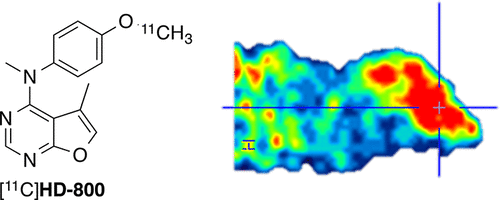当前位置:
X-MOL 学术
›
ACS Med. Chem. Lett.
›
论文详情
Our official English website, www.x-mol.net, welcomes your feedback! (Note: you will need to create a separate account there.)
Radiosynthesis and Evaluation of [11C]HD-800, a High Affinity Brain Penetrant PET Tracer for Imaging Microtubules
ACS Medicinal Chemistry Letters ( IF 4.2 ) Pub Date : 2018-04-30 00:00:00 , DOI: 10.1021/acsmedchemlett.8b00060 Kiran Kumar Solingapuram Sai 1 , Jaya Prabhakaran 2, 3 , Gayathri Ramanathan 1 , Stephanie Rideout 1 , Christopher Whitlow 1 , Akiva Mintz 4 , J. John Mann 2, 3, 4 , J. S. Dileep Kumar 2
ACS Medicinal Chemistry Letters ( IF 4.2 ) Pub Date : 2018-04-30 00:00:00 , DOI: 10.1021/acsmedchemlett.8b00060 Kiran Kumar Solingapuram Sai 1 , Jaya Prabhakaran 2, 3 , Gayathri Ramanathan 1 , Stephanie Rideout 1 , Christopher Whitlow 1 , Akiva Mintz 4 , J. John Mann 2, 3, 4 , J. S. Dileep Kumar 2
Affiliation

|
Microtubules (MTs) are highly abundant throughout the cytoskeleton, and their dysfunction is implicated in the pathogenesis of malignancies, various neurodegenerative disorders, and brain injuries. Validated radiotracers reported so far for MTs are [11C]paclitaxel, [18F]fluoropaclitaxel, and [11C]docetaxel; however, they are well-characterized substrates of efflux transporters and consequently have poor uptake into the brain due to minimal blood brain barrier (BBB) penetration. PET imaging of MT expression requires radiolabeled BBB penetrating MT ligands, and it may offer a direct and more sensitive approach for early diagnosis, monitoring disease progression, and treatment effects in brain diseases and assessing the clinical potential of targeted therapeutics and treatments. We have identified N-(4-methoxyphenyl)-N-5-dimethylfuro[2,3-d]pyrimidin-4-amine (HD-800) as a high affinity and selective colchicine site tubuline inhibitor amenable to radiolabel with C-11, a positron emitting isotope. HD-800 and desmethyl-HD-800 were synthesized in one step with 75% and 80% yields respectively from commercial synthons. The radiosynthesis of [11C]HD-800 was achieved in 45 ± 5% yield at EOS. Ex vivo biodistribution binding data of [11C]HD-800 indicate that the radioligand penetrated the BBB and it was retained in brain with 75% specific binding. Apart from the brain, specific binding was observed in muscle (55%), heart (50%), lungs (43%), blood (37%), and pancreas (30%). MicroPET imaging in mice showed excellent binding in brain that was blocked by preadministration of unlabeled HD-800 and a colchicine site binding MT ligand MPC-6827. The above results indicate that [11C]HD-800 may be a suitable PET ligand for the in vivo quantification of MT inside and outside the brain.
中文翻译:

[ 11 C] HD-800,一种用于成像微管的高亲和力脑渗透性PET示踪剂的放射合成和评估
微管(MTs)在整个细胞骨架中高度丰富,其功能异常与恶性肿瘤,各种神经退行性疾病和脑损伤的发病机制有关。迄今为止,已报告的MT的有效放射性示踪剂是[ 11 C]紫杉醇,[ 18 F]氟紫杉醇和[ 11C]多西他赛;但是,它们是外排转运蛋白的特征明确的底物,因此由于血脑屏障(BBB)的渗透极小,因此对大脑的吸收较差。PET对MT表达的成像需要放射性标记的BBB穿透MT配体,并且它可以为早期诊断,监测疾病进展和脑部疾病的治疗效果以及评估靶向疗法的临床潜力提供直接且更敏感的方法。我们确定了N-(4-甲氧基苯基)-N-5-二甲基呋喃[2,3- d] pyrimidin-4-amine(HD-800)作为高亲和力的选择性秋水仙碱位微管蛋白抑制剂,适合用正电子发射同位素C-11进行放射性标记。HD-800和去甲基-HD-800一步一步从商业合成子中合成,产率分别为75%和80%。在EOS下,[ 11 C] HD-800的放射性合成产率为45±5%。[ 11的离体生物分布结合数据C] HD-800表明放射性配体穿透了血脑屏障,并以75%的特异性结合保留在脑中。除大脑外,在肌肉(55%),心脏(50%),肺(43%),血液(37%)和胰腺(30%)中观察到特异性结合。小鼠中的MicroPET成像显示在大脑中具有出色的结合力,这可以通过预先施用未标记的HD-800和结合秋水仙碱的MT配体MPC-6827来阻断。以上结果表明,[ 11 C] HD-800可能是适合体内定量脑内外MT的PET配体。
更新日期:2018-04-30
中文翻译:

[ 11 C] HD-800,一种用于成像微管的高亲和力脑渗透性PET示踪剂的放射合成和评估
微管(MTs)在整个细胞骨架中高度丰富,其功能异常与恶性肿瘤,各种神经退行性疾病和脑损伤的发病机制有关。迄今为止,已报告的MT的有效放射性示踪剂是[ 11 C]紫杉醇,[ 18 F]氟紫杉醇和[ 11C]多西他赛;但是,它们是外排转运蛋白的特征明确的底物,因此由于血脑屏障(BBB)的渗透极小,因此对大脑的吸收较差。PET对MT表达的成像需要放射性标记的BBB穿透MT配体,并且它可以为早期诊断,监测疾病进展和脑部疾病的治疗效果以及评估靶向疗法的临床潜力提供直接且更敏感的方法。我们确定了N-(4-甲氧基苯基)-N-5-二甲基呋喃[2,3- d] pyrimidin-4-amine(HD-800)作为高亲和力的选择性秋水仙碱位微管蛋白抑制剂,适合用正电子发射同位素C-11进行放射性标记。HD-800和去甲基-HD-800一步一步从商业合成子中合成,产率分别为75%和80%。在EOS下,[ 11 C] HD-800的放射性合成产率为45±5%。[ 11的离体生物分布结合数据C] HD-800表明放射性配体穿透了血脑屏障,并以75%的特异性结合保留在脑中。除大脑外,在肌肉(55%),心脏(50%),肺(43%),血液(37%)和胰腺(30%)中观察到特异性结合。小鼠中的MicroPET成像显示在大脑中具有出色的结合力,这可以通过预先施用未标记的HD-800和结合秋水仙碱的MT配体MPC-6827来阻断。以上结果表明,[ 11 C] HD-800可能是适合体内定量脑内外MT的PET配体。



























 京公网安备 11010802027423号
京公网安备 11010802027423号